Aeroplane Homes
Floating Homes
Bubble House
Bunkers
Living in a Bus
Container Homes
Cosmic Garden
Crofts
The Crooked House
Dome House
Dome House at Sea
Dymaxion House
Eco-Homes
The Egg House
Grass Roofs
Gunnite House
Hovercraft House
Martello Towers
Modern Architecture
Mushroom House
Pickle Barrel House
Pyramid House
Living in Railway Carriages
Sculptured House
The Shoe House
Sliding House
Spanish Cave Houses
House of Straw
Toilet House
Tree Houses
Tsui House
UFO
Underground Cities
Underground Homes
The Upside-Down House
Underground Homes

I then
discovered that underground houses
were quite big in Australia, and started corresponding with some
society whose name I have since forgotten.
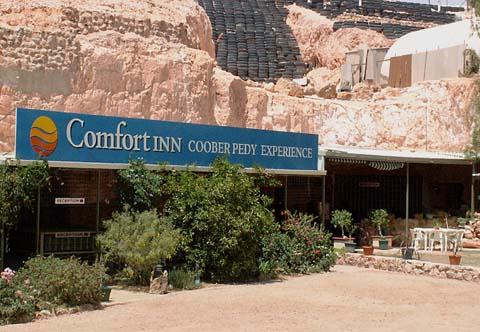
The houses there are built
in disused mining shafts, and they are dug into soft rock that hardens
upon contact with the air, just like those houses (caves) constructed
in Andalusia, and in particular in the town of Guadix.
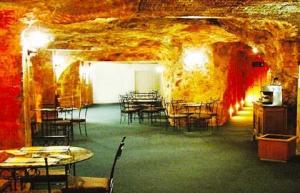
In the mid sixties I hitched all round Spain, and visited the town of Guadix. I knew all about it from the writings of novelists and poets. I was particularly interested at the time in the poetry of Garcia Lorca (I translated his Romancero Gitano, or Gipsy Ballads, in the sixties), and so I was prepared for a town that had a front but no back; that had balconies but few windows.
There is a town like any other down at the
bottom of the hill, but further up the hill the houses initially look
much the same, but although you walk along a perfectly normal Spanish
street, the house fronts are just the face of the rock with windows and
doors cut in, and then the rock-face painted white.
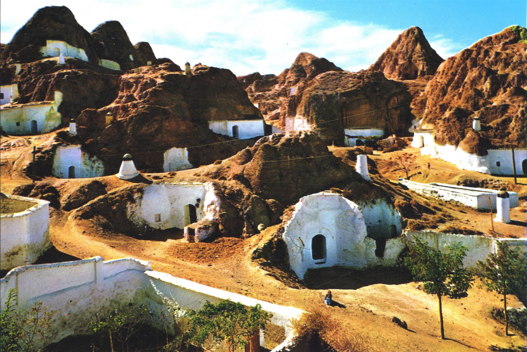
Above, the chimneys stick straight out of the ground. When you come upon the area from the "wrong" side you walk into a mass of chimneys and chained up dogs prowling around and endlessly barking. Ground level is the roof level. They are the balconies of the moon of some of Lorca's poems.
And the horizon of dogs he describes is the sound you get at night when you are in the middle of the plain and you can hear the villages around you, probably each village being 3 to 10 kilometres away. You hear the dogs on the roofs barking at some disturbance, and then barking at each other: a sound which seems to keep going all night long.
Inside these houses is much like the inside
of any other house, except that all the back rooms have no windows. The
rooms are all gaily painted. They are dry, full of furniture and
furnishings in the ordinary way, and look very pretty.
The houses I stayed in were very warm and comfortable, and the owner used to say that when they wanted more room they just dug into the rock and excavated more space.
The rock is hard when exposed to air, but
once get beyond that hard surface it becomes easy to hack out to make
more space. So underground houses were initially cheap to make.
In Australia the same could be said of the
houses constructed out of the mine shafts. There are especially fine
houses cut into the opal-filled rock at Couper Peedy. These properties
also have another advantage, they are cool in the long hot summers.
Coober Pedy is a mining town located some
850 km north of Adelaide, Australia. Because of the harsh summer
weather, people here prefer to live in authentic underground homes,
carved inside caves. Everything is underground: the houses with all
sorts of facilities, opal shops and mines, graveyards, billiard rooms,
bars, swimming pools, museums and of course the Serbian Orthodox Church
too. Living underground may sound a little scary to you, but in
reality, the houses are gorgeous, with rosy sandstone walls. The name
Coober Pedy developed from the Aboriginal "kupa piti", which means
“white man's hole in the ground".
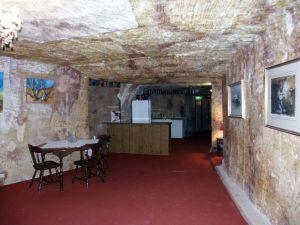
There is a great deal to experience in this
small town. The world’s longest “dingo fence” passes through Coober
Pedy, and is actually the longest structure in the world. The local
golf course has no grass but the Coober Pedy Golf Club is the one and
only club in the world to enjoy reciprocal rights at The Royal and
Ancient Golf Club of St. Andrews. It’s the experience of a lifetime to
play golf at night with glowing balls.
In the UK underground residences came late in the day, but they came for two reasons, neither of which were the reasons given above. First, there were often problems with planning authorities. A house which was constructed below ground level was not likely to overlook other properties, or spoil the view from neighborouring properties, therefore in many areas such developments were regarded as less damaging to the visual environment, and therefore accepted, whereas an above ground development might well not be accepted.
Secondly, it was found that houses constructed below ground were surprisingly warm in winter. One of the advantages of underground houses is that the year round temperature hardly varies. One writer puts the average annual variation in the UK at 10 degrees Fahrenheit. However, with today's obsession with environmental matters, the first reason is now a prime reason for choosing to build underground.
I found there were a couple of people building underground in the seventies, and chanced across the work of Arthur Quarmby. I still have some of his leaflets, and a copy of a paper he gave to the International Conference on Earth Sheltered Buildings in Sydney, Australia in 1983.
In this paper he talks about and shows
illustrations of his own home under the Pennines. He emphasizes that
the architecture of an underground house need not, and indeed, should
not, be like that of an above-ground home.
And below is a picture above ground. All you see is the
chimney and the main atrium light.
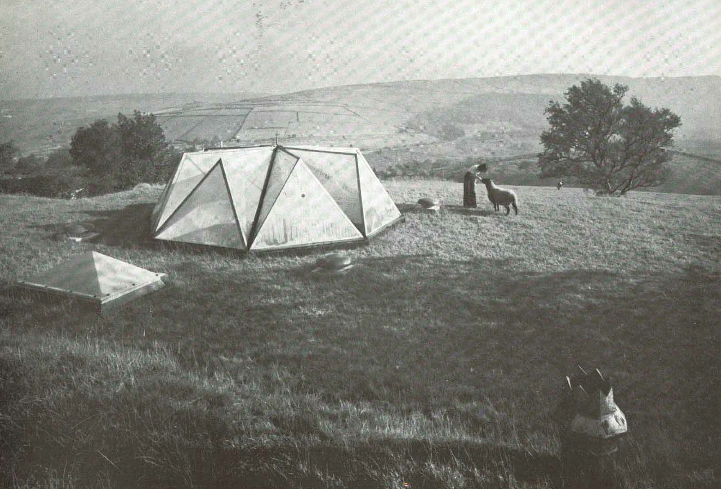
His own seemed to be constructed round a
large communal area which itself was centred round a figure of eight
swimming pool. This sunken area was surrounded by a great arched
structure topped by an atrium protruding above ground and allowing
sunlight into the room. This sunlight was magnified by reflectors
placed to angle the light into the whole living area, which also
contained plenty of plants. Off to one side is the other communal area,
the kitchen and eating area. There is also a kind of den: a small area
like a cave with a peat fire brazier. Whereas on two other sides are
sleeping and private areas. Each of these areas contains bedroom,
bathroom, study, and sun terrace.
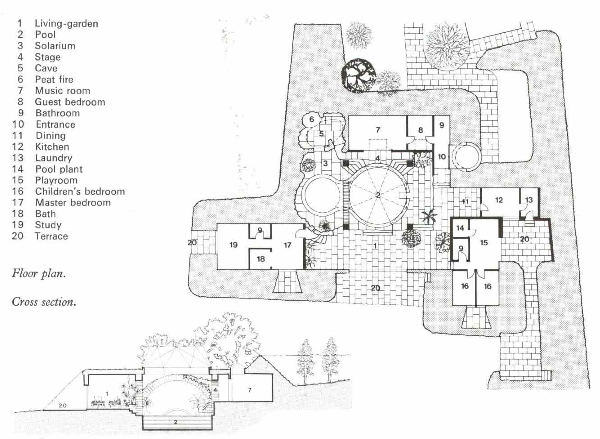
His house is cut into a hillside which
slopes gently to the south, and is cut 4.8 metres (16 feet) deep. The
property was constructed, and then rocks and earth backfilled, with 8
inches of soil on the roof to allow grass to grow.
The living room in the centre of the house built under the Penines.
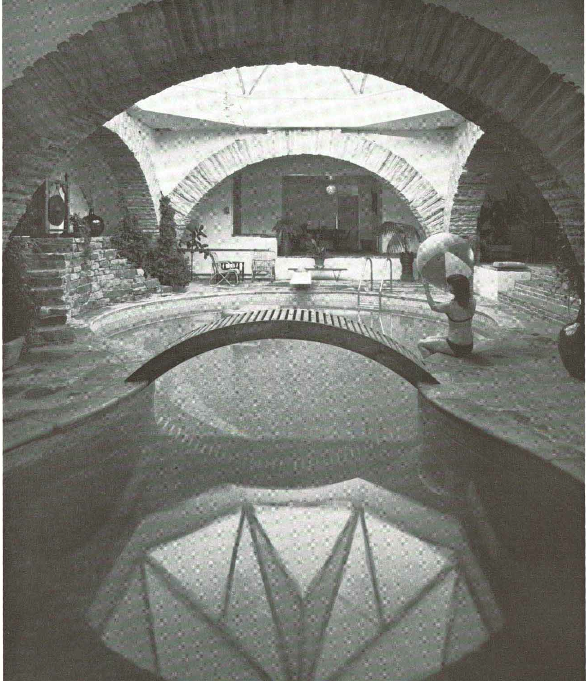
There is always the problem of danger from water pressure. The rainfall is copious in the UK, and water pressure increases quite substantially once you go more than a couple of feet down into the water table. When water accumulates to the point of saturating the soil, the water table rises. Below this saturation line ground water will place 62.4 pounds of pressure per square foot against a structure for every foot of depth. This is not a lot to start with, but at eight feet below the water table the hydrostatic pressure is 500 pounds per square foot. That is a lot.
This means that water uphill of the
property must be deflected and encouraged to flow around the house. It
also means that the full force of the pressure from the surrounding
ground must not be brought to bear on the walls of the house itself. To
this end "free standing agricultural clamp units are used all round the
house. These are vertical blades of extremely dense reinforced concrete
with a large toe sticking outwards and a short heal inwards. The toe is
loaded with the backfill which is then piled up the blade to the
required height." Apparently these units are readily available and
cheap. They are also relatively impervious to water.
The floor slab, four inches thick, is poured over eight inches of thoroughly compacted gravel with a sand topping. The concrete rests on a one-inch layer of foam insulation and a sheet of six-mil polyethylene which serves as a vapour barrier.
Heat transmission losses in an earth sheltered house are so small during winter that the heat gained from the internal load and passive solar windows is greater on average than the heat loss through the building envelope. During cloudy weather and extremely cold snaps, a small backup heater is required.
Quarmby's house does not suffer from high
humidity, and because of the arrangement of windows it is very light.
There are windows to the south, facing out from the hillside, and the
atrium collects light from 360 degrees. This means the sunlight can be
reflected down into the central room, and from there across the whole
habitable space.
You can read more about this interesting underground house.
As a general principal it is desirable to
create one fairly large space, flood it with sunlight from above, add
vegetation, and have smaller more private spaces ranged round this
central living space.
For more information, have a look at this book: Underground
Homes.